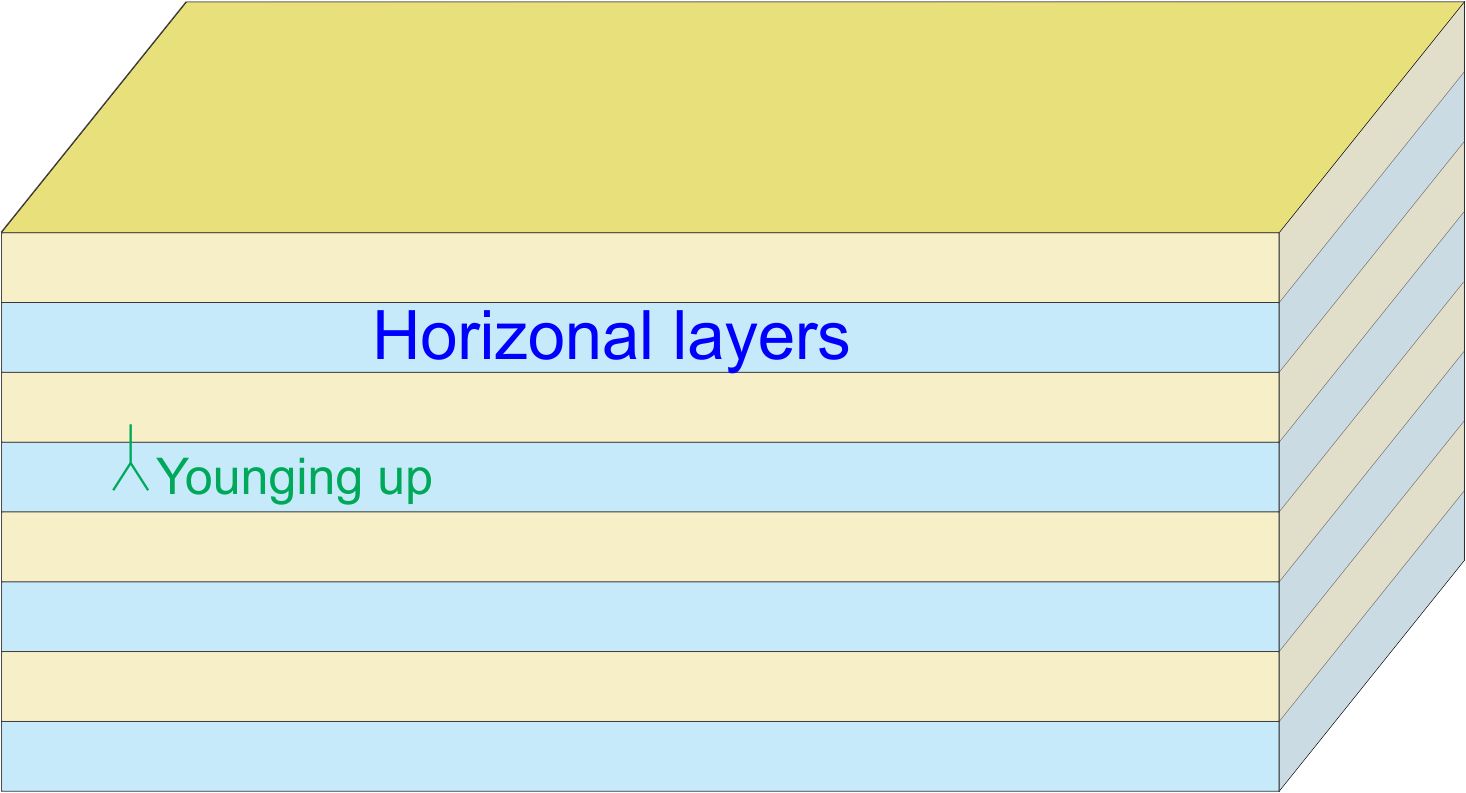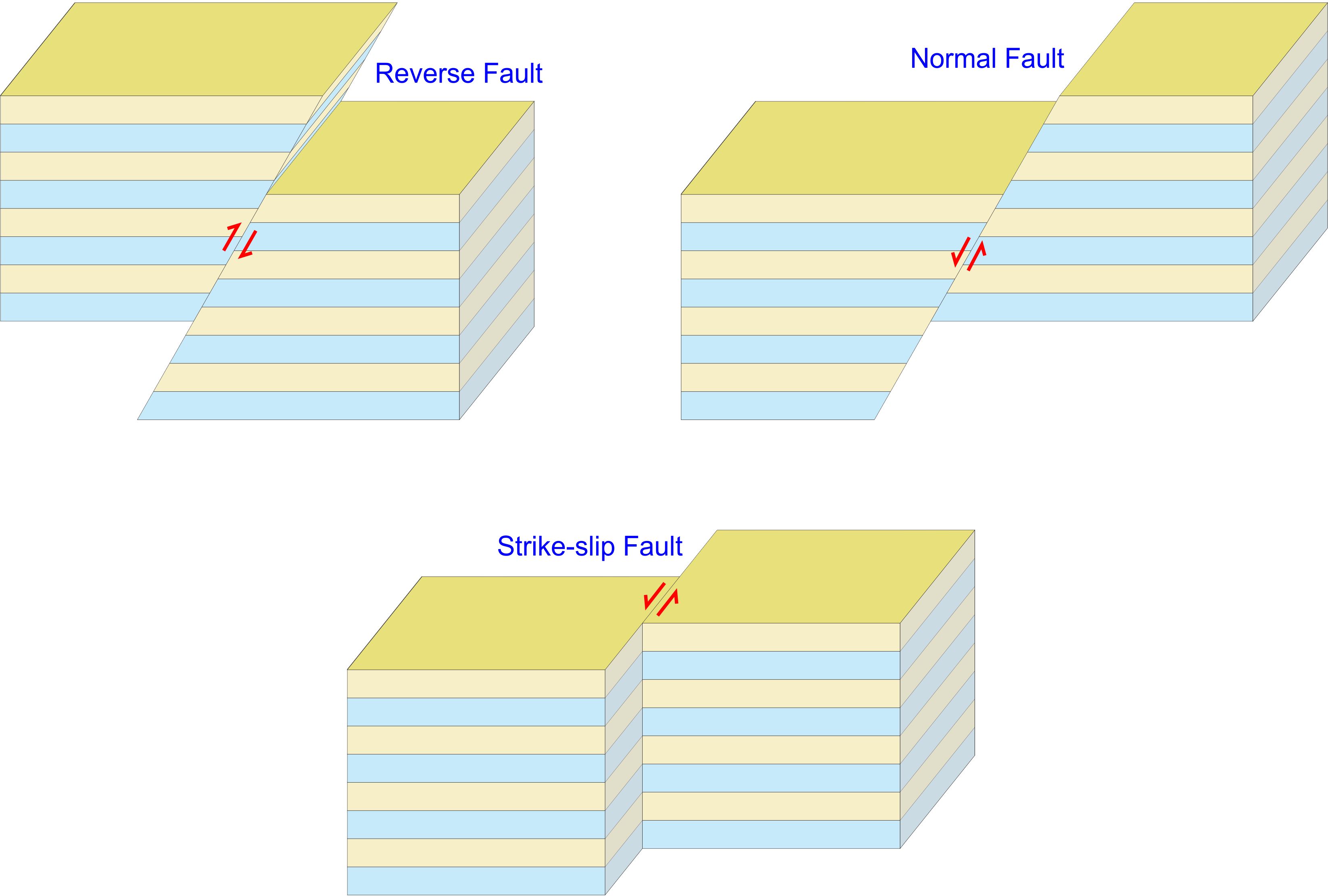Structural geology
Most rocks have been moved, crunched and bashed since they formed. Structural geology investigates the features within a rock that reveal the violent history a rock may have been subjected to. Rocks under immense pressure will bend (fold), break (fault) or crack (joints).
Primary structures
 Primary structures are the original structures within a rock that act as reference markers to tell a geologist how the rock has been deformed. The most important for geologists is the original layering. Sedimentary layers (beds) are successively built up over time, with younger beds deposited on older beds. Usually beds are deposited horizontally. In central Victoria it is usually safe to say that any rock on top of another is younger than the rock beneath. Geologists call this the younging direction and use and inverted "Y" symbol to indicate the direction in which the rocks are getting younger.
Primary structures are the original structures within a rock that act as reference markers to tell a geologist how the rock has been deformed. The most important for geologists is the original layering. Sedimentary layers (beds) are successively built up over time, with younger beds deposited on older beds. Usually beds are deposited horizontally. In central Victoria it is usually safe to say that any rock on top of another is younger than the rock beneath. Geologists call this the younging direction and use and inverted "Y" symbol to indicate the direction in which the rocks are getting younger.
A variety of features within a rock can assist to confirm younging direction. Tree roots or burrows are fossil evidence for younging. Ripples in sandstones can be found in some rocks in central Victoria. Another common feature of the rocks in central Victoria is changes in grain size, where near the top of the sandstone it may grade from fine sandstone to very fine sandstone to silt to shale. This is known as fining upwards and indicates the rock is younging upwards.
Primary structures or the original structures within a rock are depicted by the notation "S0" by geologists.
Imposed structures - folds
 The rocks throughout central Victoria have undergone horizontal compression, mostly in an east-west direction and often multiple times. Several types of imposed structures occur as a result of this compression and a common example is folding. Folding can be mimicked with a book or a tablecloth. Pushing on one end will resulting buckling or bending, known to geologists as folds. If the beds are folded upwards and beds young away from the centre of the fold, it is known as an anticline. If the beds are folded downwards and the beds young towards the centre of the fold it is known as a syncline.
The rocks throughout central Victoria have undergone horizontal compression, mostly in an east-west direction and often multiple times. Several types of imposed structures occur as a result of this compression and a common example is folding. Folding can be mimicked with a book or a tablecloth. Pushing on one end will resulting buckling or bending, known to geologists as folds. If the beds are folded upwards and beds young away from the centre of the fold, it is known as an anticline. If the beds are folded downwards and the beds young towards the centre of the fold it is known as a syncline.
The point of tightest curvature in a fold is known as the hinge. The line that joins the hinge points along a bed is known as the fold axis. The plane that connects all the hinge points in three-dimensions is known as the axial plane.
In central Victoria most of the axial planes of folds are upright close to vertical (upright). It is common for the fold axis to be tilted at a shallow angle, this is known as shallowly plunging. A good example of a shallow plunging fold can be seen at Castlemaine.
Imposed structures - cleavage
An interesting feature of the rocks in central Victoria is the development of cleavage in response to folding. During folding, the minerals in the rock rotate in reposonse to the folding. This is best seen in shales where the clay minerals align parallel with the axial plane of the fold. Geologists refer to this as axial planar cleavage. However in sandstones, fractures will tend to develop at right angles to the layering and sometimes the sand will disssolve along these fractures to produce solution cleavage.
The first imposed cleavage on a rock is depicted by the notation "S1" by geologists. Sometimes a second or third cleavage overprints the earlier cleavages and these are referred to as "S2" or "S3".
Cleavage is very helpful for the geologist to demonstrate the orientation of the axial plane, to demonstrate which direction a geologist needs to look to find and anticline or a syncline and to assist to unravel complex folding histories.
Quartz will often infill existing planes of weakness in a rock and form quartz veins. Veins can form on cleavage (both axial planar or solution) or follow beds. Veins can also form on faults and joints, a described below.
Imposed structures - faults

 During compression, fractures can develop in the rocks and can have displacement associated with the fracturing, known as faulting. Commonly in Victoria, the rocks above the fault are pushed over the lower rocks to create reverse faults. Often the faults in sedimentary rocks in central Victoria will follow bedding until they reach an anticline and will then break across the beds on the opposing limb of the fold (known as a limb-thrust fault).
During compression, fractures can develop in the rocks and can have displacement associated with the fracturing, known as faulting. Commonly in Victoria, the rocks above the fault are pushed over the lower rocks to create reverse faults. Often the faults in sedimentary rocks in central Victoria will follow bedding until they reach an anticline and will then break across the beds on the opposing limb of the fold (known as a limb-thrust fault).
When the upper block slides downwards in relation to a lower block along a fault it is referred to as a normal fault. These are common elswhere around the world but are rarely seen in central Victoria. When blocks move sideways along a vertical fault, it is referred to as a strike-slip fault or transverse fault. Some strike-slip faults occur in Victoria but a good example of an active strike-slip fault is the San Andreas Fault in southwestern USA.
Imposed structures - joints
Fractures that develop within a rock that have no visible displacement associated with them are known as joints. Radial joints will commonly occur around sandstone beds. Joints can occur along the length of the fold or across the face of the fold. Joints are common in igneous rocks in Victoria.
A common joint that forms in sedimentary rocks in central Victoria occurs as a result of faulting. Tension joints are usually horizontal and extend for a limited distance away from faults.
Quartz veins will often fill joints and faults in central Victoria.